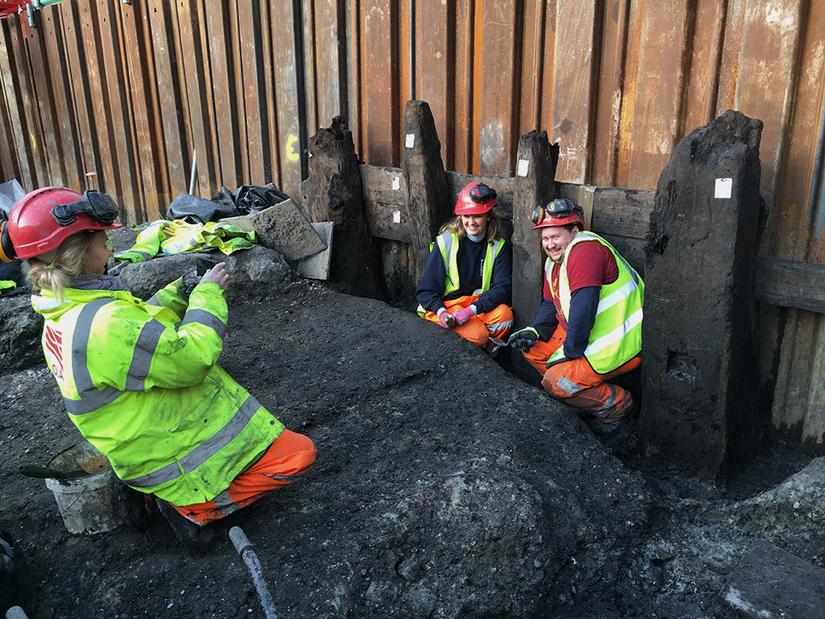Timber! The archaeology of Britain’s ancient forests
As archaeologists we sometimes come across evidence for ancient forests, long since disappeared, which populated the British Isles after the last Ice Age drew to a close. In this blog, archaeological woodwork specialist Damian Goodburn explores the different types of evidence we find, and what we can learn about how forests have been used and managed over the centuries.
The wet ground in many parts of Greater London and the Southeast of England contains rare hidden evidence of ancient forests of the last four thousand years or so. We dig up prehistoric and early historic trees in the form of worked timbers, fallen trees and even stumps of trees that grew thousands of years ago. Some are also found on the eroding foreshores and coasts surveyed by CITiZAN and the Thames Discovery Programme around the country.
From dense, dark wildwood with tall, straight oaks over 200 years old, to strange riverine forests of yew and oak along the east London Thames, archaeological evidence for ancient forests has been recorded for centuries, starting with Gerald of Wales, who came across Newgale submerged forest during a tour of Wales in 1188:
"The sandy shores of south Wales laid bare by the extraordinary violence of a storm, the surface of the earth, which had been covered for many ages, reappeared, and discovered the trunk of trees cut off, standing in the very sea itself, the strokes of the hatchet appearing as if made only yesterday."
Some centuries later in September 1665, during excavations for a dock in Blackwall, Samuel Pepys recorded in his diary the discovery “12 foot underground” of:
"Perfect trees over-covered with earth. Nut trees, with the branches and the very nuts upon them…. Their shells black with age, and their kernell, upon opening, decayed, but their shell perfectly hard as ever…"
Evidence of ancient forests and managed woodland is sometimes found, of types of forests and woods now extinct in Britain. Samples of late Iron Age wildwood oaks shaped into massive squared quay beams have been excavated on several City waterfront sites. Some of the photos have a human scale in them, emphasizing how big the timbers were and the even larger trees they were made from.

Evidence of ancient forests and managed woodland is sometimes found, of types of forests and woods now extinct in Britain. Samples of late Iron Age wildwood oaks shaped into massive squared quay beams have been excavated on several City waterfront sites. Some of the photos have a human scale in them, emphasizing how big the timbers were and the even larger trees they were made from.
By 1600, the great ‘old growth’ forests of North America and later also tropical parts of the British Empire were being exploited for their high quality, large timbers for use as ships masts, large building timbers, and in dock building. It is well known from written sources from the 17th century onward that some British landowners set out to plant trees from these distant lands; such as Continental European and American conifers and even Australian Eucalyptus, to try to produce similar timbers in Britain.
Interestingly, recent discoveries are showing that these attempts to introduce foreign tree species began much earlier than previously thought, in the Roman period. It may even be that the ‘quintessentially English’ common elm tree was actually a Roman introduction, as some geneticists have suggested. The earliest evidence of the use of elm in construction in the Roman period has just been found by MOLA Headland archaeologists working on the A14 Cambridge to Huntingdon Improvement Scheme; the only securely dated elm-built Roman timber structure excavated in the UK to date.
Most of the stories the timber evidence tells are ones of over exploitation, but there are also indications from prehistoric times of people’s attempts to manage woodland sustainably. Evidence for 'woodmanship techniques' such as coppicing can be seen on ancient trees which have survived to this day, suggesting that they were nurtured as well as harvested. Some of these ancient managed woods can still be seen in the Southeast of England, but the great wildwood that once covered areas like the Weald of Kent, Sussex, and Surrey is long gone.
Damian is one of MOLA’s Senior Finds Specialists, specialising in woodwork. He is an acknowledged international expert in ancient timber recording, analysis and publication with a PhD in Medieval shipbuilding.

